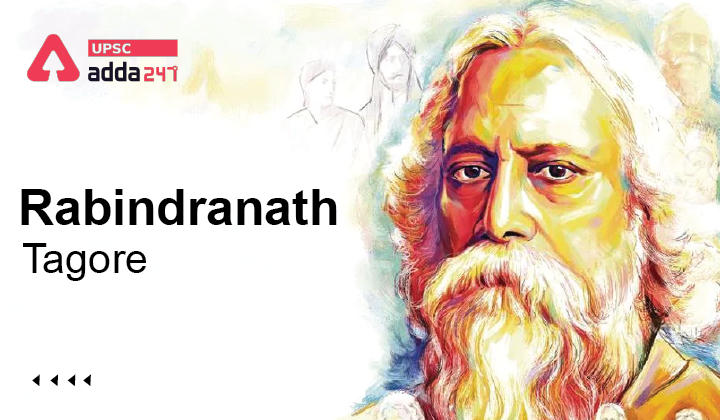Table of Contents
Rabindranath Tagore- Relevance for UPSC Exam
- GS Paper 1: Modern Indian history from about the middle of the eighteenth century until the present- significant events, personalities, issues.
Rabindranath Tagore in News
- Recently, India celebrated Gurudev Tagore Jayanti. On the occasion of Rabindranath Tagore Jayanti, the Prime Minister, Shri Narendra Modi has paid tributes to Gurudev Tagore.
Key Facts about Rabindranath Tagore
- About Rabindranath Tagore: Rabindranath Tagore, a multitalented personality, was a Bengali poet, novelist, a painter,and also v=credited with composing the National Anthem of India.
- Marriage: Rabindranath Tagore married Mrinalini Devi in 1883, a child bride as was the tradition in those times.
- Nobel Prize in Literature: Rabindranath Tagore also won the Nobel Prize for Literature in 1913 for his work on Gitanjali.
- Rabindranath Tagore was thefirst non-European to receive the Nobel Prize.
- Rabindranath Tagore was highly influential in introducing Indian culture to the west.
- Beliefs: Rabindranath Tagore was opposed to nationalism and militarism as a matter of principle.
- Tagore, on the other hand, promoted spiritual values and the creation of a new world culture founded in multi-culturalism, diversity, and tolerance.
- Rabindranath Tagore Birth: Rabindranath Tagore, Bengali Rabīndranāth Ṭhākur, was born May 7, 1861 in Calcutta [now Kolkata].
- British Knighthood: Rabindranath Tagore Rabindranath Tagore in 1915.
- However, following the Jallianwalla Bagh massacre he renounced his Knighthood in 1919.
- Death: Rabindranath Tagore, after an extended period of suffering, died on August 7, 1941, in the same mansion in which he was brought up.
- Earlier, in 1937, he went into a comatose condition, which relapsed after a period of three years.
Champaran Satyagraha – Background, Gandhiji’s Role and Outcome
Key Contributions of the Rabindranath Tagore
- Guru Shishya Model in Shantiniketan: Tagore started an experimental school based on traditional guru-shishya teaching methods from the Upanishads in Shantiniketan.
- He was in favour of reviving the traditional model of education system in India, instead of imparting western model of education to children.
- Independence movement: Tagore participated in the Indian nationalist movement from time to time in his own non-sentimental and visionary way.
- He is also credited for giving the Mahatma title to India’s political father Mahatma Gandhi. Gandhi Ji was his devoted friend.
- Opposed Partition of Bengal: Rabindranath Tagore strongly protested against the partition of Bengal in 1905. Tagore wrote many national songs and attended protest meetings against the decision to partition Bengal.
- In the Field of Education: Rabindranath Tagore established Viswabharati University in 1921.
- He also gave all his money from Nobel Prize and royalty money from his books to Viswabharati University.
- Literary Contributions: Rabindranath Tagore wrote successfully in all literary genres. Few of them are written below-
- Poems: Manasi (1890) (The Ideal One), Sonar Tari (1894) (The Golden Boat), Gitanjali (1910) (Song Offerings), Gitimalya (1914) (Wreath of Songs), and Balaka (1916) (The Flight of Cranes).
- Plays: Tagore’s major plays are Raja (1910) [The King of the Dark Chamber], Dakghar (1912) [The Post Office], Achalayatan (1912) [The Immovable], Muktadhara (1922) [The Waterfall], and Raktakaravi (1926) [Red Oleanders].
- Short stories and Novels: among themGora (1910), Ghare-Baire (1916) [The Home and the World], and Yogayog (1929) [Crosscurrents].
- Paintings: Rabindranath Tagore is also credited with numerous drawings and paintings.





 TSPSC Group 1 Question Paper 2024, Downl...
TSPSC Group 1 Question Paper 2024, Downl...
 TSPSC Group 1 Answer key 2024 Out, Downl...
TSPSC Group 1 Answer key 2024 Out, Downl...
 UPSC Prelims 2024 Question Paper, Downlo...
UPSC Prelims 2024 Question Paper, Downlo...
